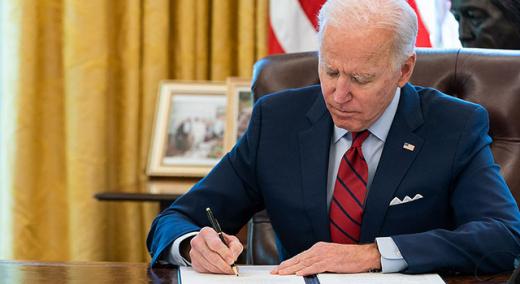‘By the authority vested in me as President by the Constitution and the laws of the United States of America, including sections 3301, 3302, and 7301 of title 5, United States Code, it is hereby ordered as follows....”
Why do these words make me cringe? Well, because when presidential ink hits paper, all the ramifications get real. All the things that make for healthy debate become regulations that impact our businesses on a daily basis—and in a big way. Today, I’m talking about President Biden’s vaccine mandates or executive orders.
|
ADVERTISEMENT |
It’s already well known that President Biden’s “Executive Order on Ensuring Adequate COVID Safety Protocols for Federal Contractors,” aka Executive Order 14043, requires all “federal workforce and individuals interacting with the federal workforce” to be fully vaccinated by Nov. 22, 2021. This is the first of two executive orders (EO) signed on Sept. 9, 2021.
…

Comments
Risk management
The risk assessment that should be done is the risk to your employees and your business from having unvaccinated employees. What's the risk of unvaccinated employees infecting each other and if one is infected in the workplace, what is the risk of serious illness or death? What is that same risk if all employees are vaccinated? Also, what is the risk of unvaccinated employees contracting COVID and running up very high medical costs or dying, in which case you have to bear the cost of replacing them? You would no doubt have to replace some workers who refuse to be vaccinated, so that would have to be factored in also. I suspect a number of compaines have done this analysis and don't care about the government mandates because they are already requiring vaccinations.
Risk Management
Risk management, with respect to health care issues, falls uner the domain of the doctor-patient relationship. My medical situation is between my doctor and me, no ne else. We don't do risk assessment studies for influenza or the common cold. Why would we do that for Covid-19? The risks for seaonal influenza vs Covid-19 are essentiaaly the same. In Canada, for exanple, out of a poulation of sone 35 million people, we have a total of about 28,000 Covid deaths in the last two years. Most people (some 97% to 99%) recover from Covid-19 -- not looking so deadly so far. Pretty much the same as seasonal influenza.
Now that vaccine mandates have taken center stage, it's all about how can we protect ourselves from "the unvaccinated" who cares if the unvaccinated are also naturally immune, having been infected with Covid 19?
You may not have heard, but vaccinated people can become infected with Covid-19, and can infect other people. These not well tested vaccines, pose a great risk, especially given that death counts and vaccine injuy counts from the Covid vaccines are far higher than wold normally be acceptable. These facts have been glossed over to create a false concern about "the unvaccinated" vs "the vaccinated". Historiucally, death rates from vaccines, when high enough, have caused them to taken off the market immediately. The death rates fron the Covud vaccines, which are not vaccines at all, but experimental gene therapy, are quite high enough to warrant immediate withdrawal of these toxic substanes from the market.
Known to be safe tratments, such as Hydroxychloroquine + Zinc + an anibiotic (early stage treatmet) or ivermectin (earaly/late stage treatment) have been available from the outset cheaply, but were banned. Estimates indicate that 500,000 lives could have been saved if these treatments had been available. Sounds kike a huge risk was taken here.
As I said, I don't know what the laws in the U.S. are, but in Canada, no one has the right to mandate a medical treatment. Allowing such mandates creates great risk, opening a Pandora's box where lawlessness reigns.
Biden's Mandates
I find it astonishing that the U.S. Constituition allows for the mandating of medical treatments. In Canada, in sptie of the fact that our politicians and health officers have been working feverishly to do so for the last two years, NO ONE can mandate any medical treatment, not even if you are a doctor. Mandating a medical treatment violates our informed conset laws, as well as several other violations of our absolutely guaranteed protections under our Constitution and Charter of Rights and Freedoms.
There is no mandate, law, requirement, recommendation, prescription or incentivization that supercedes our Charter Rights. Our Constituion is the higest law of the land.
Section 52(1) of the Constitution Act, 1982 (Canada) states that any law that is inconsistent with the provisions of the Constitution is of no force or effect. Statutes which conflict with the Constitution are invalid in the most radical sense; they do not become law.
This is true even in the event of a national emergency. The Federal Emergencies Act R.S.C., 1985, c. 22 (4th Supp.), which does not pertain to viral infections, was never invoked in Canada. In any case, as the peamble to this Act sattes:
AND WHEREAS the Governor in Council, in taking such special temporary measures, would be subject to the Canadian Charter of Rights and Freedoms and the Canadian Bill of Rights and must have regard to the International Covenant on Civil and Political Rights, particularly with respect to those fundamental rights that are not to be limited or abridged even in a national emergency;
Most people in Canada do not know their rights, and have followed along, not only with vaccine mandates, but with all the Covid mandates. By compling with them you are breaking the law.
That such Executive Orders by a President in the United States could be considered valid and lawful, it truly astonishing.
Bravo!
Bravo!
Add new comment